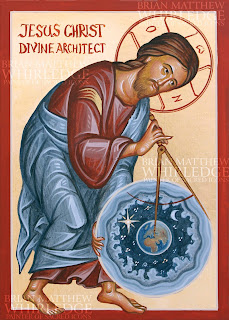St. George Staro-Nagoricane
This morning, we visited two important monastery churches. First, we drove an hour from Skopje to the 14th century monastery church of St. George at Staro-Nagoricane. Staro means "old" and Nagoricane (Na-gore-EE-chan-ae) means "burning." This monastery contains the second-largest complex of medieval frescoes in the world (the first largest is at Decani, which I'll visit on Sunday, God-willing).
This masterpiece of Christian art was built in the early 14th century by King Milutin and frescoed by his court painters Evtychiye (Eutyches) and Michael Astrapas. It was built on an older basilica church as this had already been a monastic site for centuries. First, we visited an 11th century hermitage cell of the saint who founded the monastery.
This is one of the only churches to still have its original iconostasis, still with the original icons. The icons are painted in fresco, not on wooden panels, and the two principal icons interestingly feature St. George on the left and the Mother of God on the right. Christ and his Mother are in their usual positions on the columns on each side of the iconostasis.
These frescoes by Evtychiye and Michael Astrapas are absolute masterpieces, as are all their work. Only a handful of their 40 churches survive. Most of the surviving churches are small, remote, country churches and monasteries. King Milutin also built Cathedrals as well as monasteries in Constantinople and in the Holy Land. These large churches once contained masterpieces like these on a larger scale, but do not survive, thanks to the Turkish and Islamic intolerance. You can see the Ottoman damage to the faces of the frescoes above and on the iconostasis.
I sketched this wonderful fresco of my patron, St. Matthew. I love the lively folds in his draped garments.
The narthex contains 365 frescoes, commemorating saints on every day of the year. This church is very narrative, showing scenes of martyrdom of many saints.
Sadly, this incredible church is being neglected and is in a poor state of preservation. Ivan (our guide) said the frescoes have noticeably deteriorated in the last few years since he last visitied. The church is near the Serbian border, and Serbs live in the village. A Serbian priest used to serve this church, and the Serbian Church helped to conserve the frecoes. This church was forceably stolen by the non-canonical and unrecognized Macedonian Orthodox Church a few years ago, and since then, it has been neglected.
A sketch of Saint Luke the Evangelist, who is the patron saint of iconographers. The purple of his clothing is fantastic!
I've made friends with several world-class iconographers from Russia who have joined us in Skopje. One of them,
Aleksei, told us we have to see the frescoes in the sacristry, which are all in excellent condition. Evidently, the entire church was this well preserved a decade ago.
When the time came to leave and everyone was leaving the church, I quickly scrawled what I could of this dynamic icon of St. George in my last seconds in the church.
This church has been one of my favorites. It is so amazing to see frescoes in person that I have studied for years.
Monastery of St. Gabriel in Lesnovo
After a few wrong turns and literally digging our way through a road block, we finally made it up the mountain to the remote village of Lesnovo.
We provided some free labor for the village of Lesnovo so we could get through!
The view of the plain from the mountain village of Lesnovo.
The picturesque village of Lesnovo.
Lesnovo Monastery was founded by Saint Gabriel of Lesnovo in the 10th century. He begun his monastic life at Staro-Nagoricane and retreated to Lesnovo to live in one of the many caves on the mountain.
The beautiful grounds of Lesnovo Monastery
The church was built by King Dusan, the grandson of King Milutin, and frescoed in 1341. The anonymous painters were clearly influenced by Evtychiye and Michael Astrapas, who painted in the region during the previous generation. The colors are brilliant and the skin is modelled beautifully. The proportions are a little less elegant than Milutin's painters, maybe even a little youthful or childlike.



































Comments
Post a Comment